Abstract
Latent heat storage in district cooling systems (DCS) offers advantages such as energy efficiency, load shifting, and flexibility. It optimizes energy utilization by storing thermal energy during off-peak hours and using it during peak periods. This results in cost savings, a reduced environmental impact, and the enhanced reliability of the cooling system. In the present study, a novel system consisting of a phase-change material (PCM) tank coupled to a 120 kW chiller generator for cooling is proposed. During peak cooling loads, the proposed PCM tank is intended to supply consistent thermal power at an appropriate temperature. The system is modeled using the lumped-capacitance approach, and the effective thermal capacity approach is used to model the PCM’s phase-transition phenomena. The system’s dynamic performance is evaluated, and the impact of various parameters during the PCM-tank discharging process is analyzed. The computational findings are compared to experimental data taken from a real district network, and there is excellent agreement. Results showed that increasing the needed heat rate for the cooling process from 120 kW to 160 kW decreases the PCM tank’s discharging duration by about 20% and increases pump energy consumption. It was also found that increasing the capacity of the PCM tank is advantageous for the cooling process as it extends the duration of 120 kW constant power production by about 62% when the tank volume is increased from 5 m3 to 10 m3. Finally, it was shown that the choice of the PCM type is crucial for improving the cooling performance. Erythritol is a suitable storage medium in the tank compared to A118 and MgCl2·6H2O, and using erythritol instead of PCM A118 increases the period of continuous thermal power generation by about 67%.
1. Introduction
The progressive increase in temperature resulting from climate change in combination with steadily improved life standards are contributing to the increase in cooling needs around the world [1]. Arid countries and countries located in the Mediterranean area are particularly affected as the latter have been suffering from heat waves with increasing intensity, duration and frequency.
Solar cooling technologies are gaining popularity as an environmentally friendly cooling technique that might be an alternative to traditional vapor compression cooling [2,3]. Solar cooling captures solar energy and utilizes it in a thermally powered cooling process to produce cold water or conditioned air. Thermal energy storage (TES) is an important component in these solar-powered cooling systems as it allows for the efficient utilization of solar energy by storing excess thermal energy generated during the day for use during periods of low or no solar radiation, such as nighttime or cloudy days. TES systems help overcome the intermittent nature of solar energy and ensure a continuous supply of cooling. Solar energy, being a sustainable source of energy, has the benefit of lowering greenhouse gas emissions, which is vital for conserving ecosystems [4]. Solar energy may help enhance air quality and minimize water consumption associated with energy generation [5].
For the needs of heating, ventilation, and air-conditioning (HVAC), district cooling (DC) is rising in popularity [6]. DC comprises several high-capacity chillers located within a DC plant that distributes chilled water and provides air conditioning to buildings connected to the system. A DC system (DCS) is an ideal energy-saving system for HVAC since it utilizes the efficient systematic production and distribution of chilled water. It additionally makes full use of the variety in cooling requirements for diverse buildings as well as the economies of scale. Depending on the individual configuration of each DCS, a saving of about 20% and 35% can usually be achieved with a DCS as compared to traditional air-conditioning systems [7]. The installation of a DCS also ensures a reduced greenhouse gas emission of hydrofluorocarbons as well as carbon dioxide as result of minimization of fossil fuel consumption for power generation. DCS also enhances flexibility and reliability; unlike a traditional centralized air-conditioning system, a DCS is typically built with standby cooling capacity to ensure that cooling remains available at the central plant at any time. As such, DCS provides commercial buildings with more reliability.
Generally, thermally powered cooling processes utilize thermal energy to efficiently produce cold water or conditioned air. Common types include absorption cooling, adsorption cooling, desiccant cooling, thermoelectric cooling, and thermoacoustic cooling. Absorption cooling uses a refrigerant absorbed into an absorbent material, while adsorption cooling utilizes a solid adsorbent to adsorb and desorb a refrigerant. Desiccant cooling removes humidity from the air using moisture-absorbing desiccant materials. Thermoelectric cooling employs the Peltier effect to transfer heat and create a cooling effect. Thermoacoustic cooling utilizes sound waves and temperature variations for cooling. These processes offer sustainable and environmentally friendly alternatives to conventional air conditioning systems. They can be driven by waste heat, renewable energy sources, or solar energy. Thermally powered cooling technologies find applications in various sectors, including commercial buildings, industrial processes, and decentralized cooling systems. By reducing the reliance on electricity, these processes contribute to energy efficiency and minimize environmental impact.
In the late 19th century, pipeline refrigeration systems employing either pressurized ammonia or brine solutions as distribution fluids constituted the first generation of district cooling (1GDC) [8]. Between 1960 and 1970, the second generation (2GDC) was made available. It was built on the larger compression-cooling systems and cold-water distribution fluid [8]. The third generation of cooling systems (3GDC) used water as the transfer fluid and included a more diverse cold supply using absorption cooling systems, compression chillers, surplus cold streams, and cold storages [9]. The use of locally accessible resources and the phase-out of refrigerants with substantial ozone layer depletion are two characteristics of 3GDC. The fourth generation (4GDC), a smart district cooling system that is able to communicate with the electricity, district heating, and gas networks, is currently being developed [10]. Recently, the latest generation of DC (fifth generation 5GDC) is also under way and its description is summarized in Ref. [11]. In fact, district cooling systems have evolved to incorporate 4GDC and 5GDC advancements. The 4GDC systems prioritize energy efficiency and sustainability. They utilize high-efficiency chillers with advanced technologies like variable speed compressors, heat recovery, and optimized controls. TES allows excess cooling capacity to be stored and used during peak demand periods, improving system performance. The integration of renewable energy sources further reduces the reliance on conventional energy and minimizes environmental impact. Smart controls and monitoring optimize system performance, enabling load management, predictive maintenance, and demand response capabilities. District energy network optimization minimizes energy losses and improves efficiency. The 5GDC system builds upon 4GDC advancements, aiming to enhance efficiency, sustainability, and smart capabilities. Advanced heat recovery captures waste heat from various sources for space heating or other purposes. Integration with urban systems like smart grids and intelligent transportation optimizes energy usage and enhances urban sustainability. AI and machine learning enable predictive modeling, fault detection, and optimization. Decentralized cooling distributes smaller systems for localized control, load management, and reduced losses. Enhanced digitalization, including the IoT, data analytics, and cloud computing, enables real-time monitoring and integration with smart city services. Globally, 4GDC and 5GDC advancements aim to improve energy efficiency, reduce environmental impact, and integrate with other urban systems.
An essential problem is how energy storage technologies are integrated into the energy system. When TES systems are properly integrated, they may lower operating costs, improve efficiency and dependability, decrease emissions, and enable the use of renewable energy sources [12]. TES is made up of either cold or hot energy that has been stored in a material that enables its subsequent use in thermal or electrical applications [13]. TES units are employed in DC to store energy for cooling at night when power is less expensive. During the daytime period, this energy is released for the cooling operation. As a result, the district cooling plant’s running expenses are decreased. Utilizing TES tanks in DCS improves chiller performance while lowering capital expenditures, energy costs, greenhouse gas emissions, and plant size. It was reported in [14] that the disposal of cold-storage technology was the most advanced and high-economical-load management solution. Low cooling loads and a cold ambient temperature may be used to run the cooling system during off-peak nighttime hours. The flow of the refrigerant medium during the daytime at high peak might be used to provide cooling instead of a compressor. The TES tank eliminates the gap between the supply and demand of energy by reducing the usage of cooling systems during peak hours, allowing for a better cooling efficiency [15]. Fiorentini et al. [16] numerically studied a borehole sensible TES for a district cooling/heating system. The study showed that using the TES system contributes significantly to a reduction in the energy consumption and in CO2 emissions. Recently, Tang et al. [17] studied a TES by using ice as the storage medium in a district cooling located in Beijing, China. It was shown that the use of an optimal ice TES contributes to shift the peak-loads of air conditioning and reduce its energy consumption. In another study, a long-term sensible storage system was proposed by Todorov et al. [18]. The TES was studied for DC in Southern Finland and its potential for reducing the energy consumption was also evaluated.
The use of phase-change material (PCM) tanks for DCSs could present several advantages compared to sensible storage systems (such as a water tank or aquifer energy storage) because of its great energy storage capacity as well as its capacity to deliver thermal energy at steady temperatures [19]. PCMs are appropriate for use in DCS because the latent heat involved with melting/freezing may store much more energy than sensible heat storage alone [20]. Recently, Abanades et al. [21] studied the potential of using molten salt as a TES for district cooling and heating applications. The authors confirmed that the use of this kind of TES is suitable for DCS application and leads to an improvement in the network flexibility and performances. Hlimi et al. [22] investigated a PCM tank by using a spherical shell for district heating networks. The proposed TES system was numerically investigated and the effect of design and operation parameters on the system performances was presented. Based on their result, they found that the spherical-shell PCM tank for low district heating temperatures is advantageous due to its high energy-storage density. However, this system is limited only to low-temperature district cooling systems. In another study, Soh et al. [23] used a low-temperature PCM tank for cooling and heating networks. The TES storage was optimized for improving the discharge exergy efficiency and increasing the capital cost savings in DCSs. The system was also considered only for low-temperature DCSs and its feasibility for high-temperature DC applications was ignored. Bastida et al. [24] recently evaluated the potential of using latent heat storage for heating and cooling applications. The authors proposed a numerical model to estimate the state of charge of the TES during its functioning. They found that optimizing the TES is necessary to improve the performance of thermal systems where they are employed for either heating and cooling applications. Based on the previous literature review, there is a lack of research on the use of PCM tanks in high-temperature DCSs in general and its utilization for driving the chiller generator for cooling purposes in particular. Therefore, this work addresses this gap thorough investigating the thermal performances of a coupled high-temperature PCM tank-chiller generator for cooling proposed in a DC network. The aims of the present investigation were to firstly outline the potential of using a PCM tank as the main energy source to power the chiller generator at a high temperature (higher than 100 °C) in DCS during the peak demand periods; secondly, to evaluate the dynamic performances of the coupled system; and thirdly, to carry out a detailed parametric study under multiple design and operation conditions. The description of the proposed coupled system is given in the following section.
2. System Description
In DC networks, the use of TES systems plays an important role as they enable the cooling system to operate reliably and efficiently, regardless of weather conditions or time of day. The TES system under consideration in this paper is primarily made up of a cylindrical PCM tank connected to a district cooling substation. The latter is powered by absorption chillers through providing necessary chilled water to meet the cooling demand at the district level. The PCM tank is used to supply the thermal energy required to power the chiller generator in peak demand for cooling. The primary benefit of employing the PCM tank on the hot side of the absorption chiller (chiller generator) is to reduce its energy consumption during the peak load cooling period and thus lower greenhouse gas emissions. This PCM tank will power the chiller generator by supplying the required thermal power at the appropriate temperature. The selected absorption chiller is a double-effect type with a high coefficient of performance (COP) and the ability to satisfy large cooling-power needs [25]. The analyzed PCM tank is made up of numerous cylindrical tubes through which the working fluid flows on the inside and the PCM material is inserted on the outside (Figure 1). This shell-and-tube TES system is characterized by a high effectiveness and it is used in several solar applications [26,27,28]. The selection of a shell-and-tube thermal-energy storage (TES) system can be justified for several reasons. Firstly, these systems exhibit high heat transfer efficiency due to their design, which includes a bundle of tubes within a cylindrical shell, allowing for a large heat-transfer surface area. Additionally, the counter-flow arrangement further enhances heat exchange. Shell-and-tube TES systems offer flexibility in choosing working fluids for both the hot and cold sides, accommodating a wide range of fluids based on specific application requirements. They are also scalable and modular, making them adaptable to varying storage-capacity needs. Furthermore, shell-and-tube TES systems are durable and easy to maintain, with access to the tubes for cleaning and maintenance. They are known for their reliability and safety due to their extensive industrial usage. Cost-effectiveness is another advantage, with lower capital costs and reduced energy consumption during charging and discharging processes. Based on the double-effect absorption chiller’s working temperature, where the necessary temperature at the generator’s level is more than 100 °C [29], three commercial PCMs with a melting point between 115–120 °C were considered. The properties of these PCMs are summarized in Table 1. As district cooling users need a generally constant and stable cooling-power supply, the PCM tank is also intended to provide consistent thermal power to the chiller generator. This constant thermal power ranged in the present work from 120 kW to 160 kW and the PCM tank volume varied from 5 m3 to 7 m3. Table 2 contains further information regarding the PCM tank design characteristics.
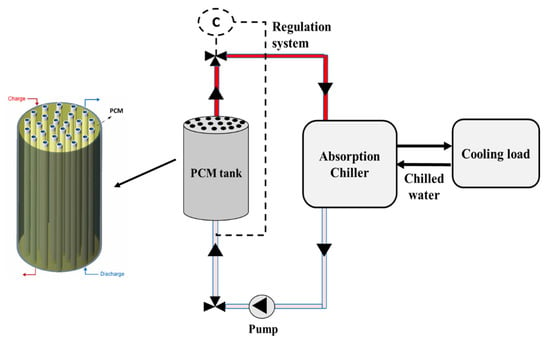
Figure 1.
The studied coupled PCM tank-absorption chiller for cooling purposes.

Table 1.
The considered PCM properties [30,31].

Table 2.
Design parameters of the studied PCM tank.
A controlled pump attached to the PCM tank is employed to generate steady thermal-power output from the PCM tank. The fluid’s mass flow rate is adjusted by this system depending on the needed thermal power at the cooling system generator as the following:
As the required thermal power by the chiller generator must be steady (constant), the mass flow rate of the working fluid must be also adjusted as the working fluid temperature varies. This regulation could be performed using a proportional–integral–derivative controller (PID controller) where it adjusts the mass flow rate based on the actual outlet temperature from the TES tank (See Equation (1)). This mass flow rate variation is limited by the maximal and the minimal capacity of the pump. Thus, based on this maximal and minimal pumping capacity of the flow rate, the variation in the working fluid flow rate may be approximated using the following equation:
where and are the outlet and the inlet working fluid temperature at the PCM tank; and and are the minimal and the maximal mass flow rate capacities of the commercial pump and they are equal to 0.2 kg/s and 1.58 kg/s, respectively. The energy consumption of the pump can be also estimated by using the Bell–Delaware method as the following:
where is the pressure drop and is the pump efficiency.
By using this proposed functioning strategy, the district substation will be powered only by the PCM tank with a constant thermal power which will lead to the stable operation of the absorption chiller and a stable cooling-power production.
3. Modelling and Verification
The adopted modelling approach of the studied thermal storage systems is based on the application of the first thermodynamics law on each studied medium. This principle expresses the fluctuation of internal energy in an individual control quantity as the total of the thermal energy exchange rate. In the PCM tank, there are two mediums identified: the working fluid and the PCM material. To study the dynamic thermal behavior of storage systems, transient energy equations and a localized-capacity (LC) modeling method are used. The LC modeling method can be a valuable approach for studying the dynamic thermal behavior of latent heat-storage systems. This method is particularly useful when dealing with systems that exhibit significant spatial variations in temperature and heat transfer. In an LC modeling approach, the storage system is divided into discrete control volumes or cells, where each cell represents a specific region or element within the system. The temperature and heat-transfer characteristics within each cell are modeled individually, considering the unique properties of the PCM, the surrounding materials, and the boundary conditions. This approach allows for a detailed analysis of the transient behavior of the latent heat storage system, capturing spatial temperature variations and heat transfer processes. By considering localized capacities, the model can accurately represent the dynamic response of the system, accounting for factors such as non-uniform heat fluxes, temperature gradients, and local phase-change phenomena. The LC method enables the investigation of various design and operating parameters, such as the effects of PCM properties, container geometry, inlet/outlet configurations, and charging/discharging strategies. It can help optimize the system performance by identifying potential thermal issues, such as overheating, thermal stratification, or inefficient heat transfer, and proposing design modifications or control strategies to address them. The adoption of this LC approach is mainly motivated by its simplicity and reduced computation time compared to the time-consuming computational fluid dynamics (CFD) approach. Indeed, the CFD method requires the resolution of several coupled partial differential equations (PDEs), which considerably increases the simulation time and requires powerful computing resources. On the other hand, with the proposed LC approach, only the resolution of the ordinary differential equations (ODEs) is necessary for each domain studied, which allows a significant reduction in the computation time. Using this modeling approach, the storage system is subdivided into several control volumes, each comprising both the HTF (high-temperature heat-transfer fluid) domain and the PCM (phase-change material) domain (see Figure 2). It is pertinent to point out that the storage system is well insulated and that the temperature is assumed to be uniform in each domain of each control volume. Due to the staggered arrangement of the tubes in the thermal storage system, a zone of symmetry forms around each tube, where no conductive heat transfer occurs. In other words, there is no heat exchange through this symmetrical region. Thus, studying only one single storage unit is sufficient to describe the whole system behavior. The same assumption for this type of shell-and-tube storage system has been adopted and validated experimentally by several authors in the literature [26,32,33].
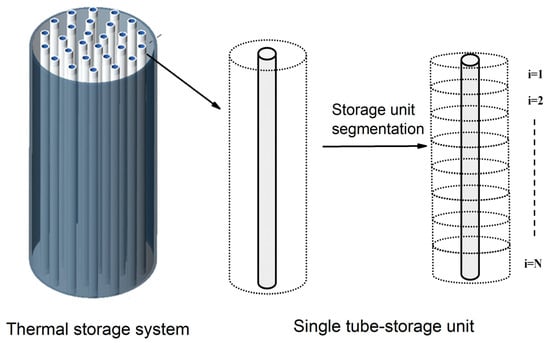
Figure 2.
Physical model segmentation.
By adopting the previous assumptions, the transient energy balance for each medium can be given as
- For the HTF medium:
Control volume 1:
Control volume 2:
Control volume N:
where and .
is the mass flow rate in one tube which is equal to the total mass flow rate divided by the total number of tubes in the storage system. In each control volume, A denotes the heat transfer surface that occurs within the HTF and the media of storage medium. The coefficient of convective heat transfer (hf) is derived using Gnielinski’s correlation as follows [34,35]:
where Dh represents the hydraulic diameter of one tube and f is the coefficient of friction.
- For the PCM storage medium:
By using the energy balance for the storage medium, the following system of equation can be obtained:
Control volume 1:
Control volume 2:
Control volume N:
The required heat for running the cooling generator varies from 120 kW to 160 kW in the examined DCS, and the maximum/minimum speed of the water pump are obtained coming from [26,36] and are 1.58 kg/s and 0.2 kg/s, respectively.
Physical phase transition is simulated in the PCM tank by utilizing a temperature-dependent heat-capacity function. When PCM is melting or solidifying, its heat capacity changes with temperature, allowing it to store more energy than a sensible storage medium whose heat capacity remains constant. The PCM heat capacity is computed as the following [26,37,38,39]:
where
The liquid fraction of PCM is represented by f(T), while the latent heat capacity is represented by Ls in [J/kg].
PCM’s baseline heat capacity may be estimated as follows:
where is the heat capacity of solid PCM and , is the one at liquid state.
PCM liquid fraction is represented by the quantity f(T), and its value can range from 0 (for the solid state) to 1 at any given temperature (for liquid state). f(T) varies during the change in phase process and may be represented as a temperature-responsive function [38,40]:
The final version of the PCM thermal-capacity function may be derived using Equation (15) as
For the purpose of simulating the transient heat transfer in PCM while the examined system is operating, the dependent temperature function described above is incorporated into the energy equations (Equations (8)–(10)). This methodology has been tested and validated against experimental measurements such as those described in the literature [38,39,41].
To verify the validity of the developed dynamic model for the PCM tank, the PCM tank model used the PCM tank’s heat-capacity function, and results from simulations were compared to realistic shell-and-tube PCM tank data gathered from published sources [36]. The current PCM tank is of the same design as that used in the experimental work of Ref. [36], where it was employed to produce the hot water for an urban heating network. It is interesting to note that the accuracy of the measured temperature in the experiment tests is ±0.5 °C. More information about this investigation may be obtained from our prior publications [20,26]. The numerical results produced by the proposed dynamic technique were checked against experimental data, and the resulting findings are displayed in Figure 3. Analyzing this result reveals that our computational model simulates the thermal dynamics of the storage system with adequate accuracy. The largest relative inaccuracy discovered is less than 5%. Based on these findings, it is possible to infer that the suggested PCM tank transient model is accurate and can accurately represent the real thermal fluctuating of the system.
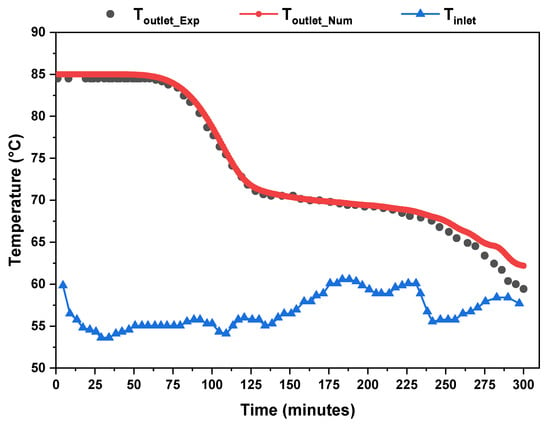
Figure 3.
Comparison between obtained numerical results and experimental data from Ref. [36].
4. Results and Discussion
This section analyzes the thermal fluctuation of the connected PCM tank to the DCS substation, as well as the influence of different design and operating factors on system performance. The confirmed PCM tank model was used for numerical simulations, and the system’s operation was examined throughout the discharge phase. During this period, the cooling loads from the DCS are assumed high and thus in general, the chiller’s energy consumption is at its peak. To reduce this chiller’s energy consumption, The PCM tank will supply the thermal power required to run the chiller generator. The chiller generator’s adequate thermal power is considered constant to support the DCS substation’s reliable operation and is set to 120 kW. As the required temperature level at the chiller generator is around 120 °C (double-effect absorption chiller), commercial PCM A118 with a melting temperature of about 118 °C is used as the storage medium and obtained results are given in Figure 4.

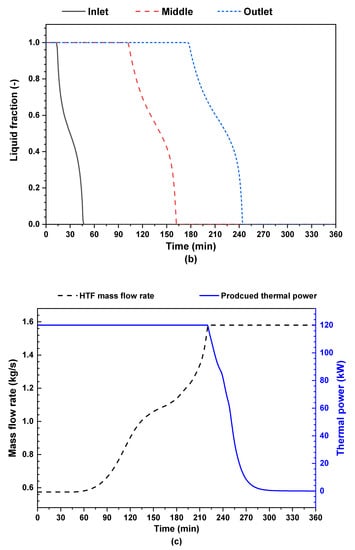
Figure 4.
(a) PCM temperature variation, (b) average liquid fraction of PCM variation, and (c) working-fluid mass flow and delivered thermal power.
The fluctuation in the temperature at three distinct points within the PCM tank throughout the discharging operation is shown in Figure 4a. It is worth noting the returned temperature that comes from the cooling generator is set at 90 °C and the tank is supposedly completely loaded with a starting temperature of 140 °C. Analyzing this figure reveals that the PCM temperature at the tank’s entrance declines quickly from 140 °C to the PCM transition point (118 °C) when compared to the temperatures at the tank’s midsection and exit. In fact, the PCM located at the tank inlet rapidly releases its heat to the working fluid which leads to a decrease in its temperature until reaching the melting point. In this period, the stored latent heat is released which is translated by the PCM temperature stabilization at 118 °C. Then, the PCM temperature continues decreasing until reaching the inlet working fluid temperature (90 °C). As the discharging operation progress, the PCM located at the middle and at the outlet of the tank follows the same previous behavior with a time lag as they are far from the entrance of the tank. The time needed to discharge the tank completely, i.e., so that the PCM tank temperature is equal to the working fluid inlet temperature, is about 5 h. This discharging behavior is confirmed in Figure 4b where the PCM liquid fraction variation is given at different locations in the tank. These findings represent the physical state change of the PCM throughout the discharge time. At the beginning of this period, all PCM contained in the tank has a liquid physical state (liquid fraction equal to one). As heat is transported through the PCM to the operating fluid during this process, the PCM temperature decreases, which also leads to change in the PCM physical state from a liquid to a solid. The PCM at the entrance of the tank changes its physical state rapidly compared to that located at the middle and at the tank outlet, as this location is the nearest to the working fluid coming from the chiller generator.
By examining Figure 4c, it is clear that the suggested PCM storage tank may benefit the chiller generator by maintaining a steady thermal output of 120 kW up to 3.6 h. This behavior is made possible by the flow rate control system, which alters the operating fluid’s mass flow rate within 0.57–1.58 kg/s according with the operational approach (See Equation (2)). The generated fluid’s working temperature coming from the PCM tank reaches a high level at the start of the discharging operation; hence, the flow rate which needs to be used is low. This flow rate increases with time as the discharging operation progresses and the produced temperature from the tank decreases.
4.1. Influence of Generator Thermal Load
Three distinct thermal power values, namely 120 kW, 140 kW, and 160 kW, were studied to assess the impact of the cooling generator thermal need on the PCM storage performances, and simulations were performed throughout the discharging process. The change in the output fluid’s working temperature is shown in Figure 5a. This result demonstrates that raising the needed power at the cooling generator causes the HTF output temperature to decrease rapidly. In practice, at the start of the discharging process, the fluid temperature at the tank exist stays constant, and the heat is discharged into the sensible form. The outlet HTF temperature decreases until reaching a plateau around 118 °C where the heat is released into the latent form. When the phase-change process is completed, the HTF outlet temperature decreases until the end of the discharging process where the HTF outlet temperature is equal to the inlet temperature. The discharge period is reduced by around 20% by raising the required thermal capacity from 120 kW to 160 kW.

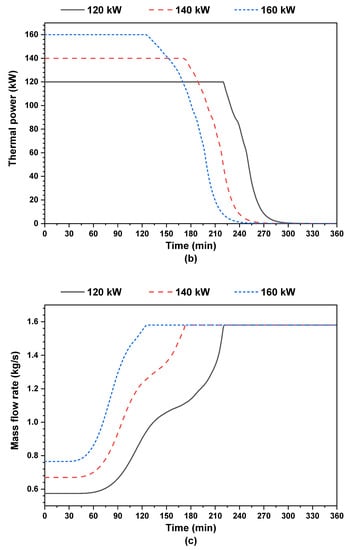
Figure 5.
(a) Outlet temperature variation from the tank, (b) generated thermal power coming from the storage unit, and (c) flow rate variation of the working fluid.
Figure 5b confirms that under various operating circumstances, the suggested PCM tank can supply the requisite thermal power to operate the chiller generator. The produced thermal power remains constant for about 2.1 h, 2.9 h and 3.7 h for 160 kW, 140 kW and 120 kW, respectively. The length of the continuous thermal power generation is lowered by about 43% by raising the necessary thermal power for the cooling process from 120 kW to 160 kW. Regarding the mass-flow regulation system, when the cooling generator’s needed thermal power is raised, peak water-flow values are obtained. (Figure 5c). To fulfill the chiller generator’s thermal-power need, the mass flow rate is enhanced to extract high thermal energy rates stored in the PCM unit in the discharge operation. After 126 min from the start of the discharge period, the pump’s maximum capacity is achieved. However, this maximal value is reached after 220 min from the beginning of the discharging process. This result can be translated by the increase in the pump energy consumption with the cooling loads.
Figure 6 shows the evolution of the consumed energy by the used regulated pump system. These results were obtained through determining the actual mass flow rate and determining the cumulated pump energy consumption from Equation (3). This graph illustrates how an increase in the chiller generator’s necessary thermal power results in an increase in pump energy usage. At the end of the discharge process, the pump energy consumption is equal to 420 Wh, 475 Wh and 512 Wh for a required chiller thermal power of 120 kW, 140 kW and 160 kW, respectively.
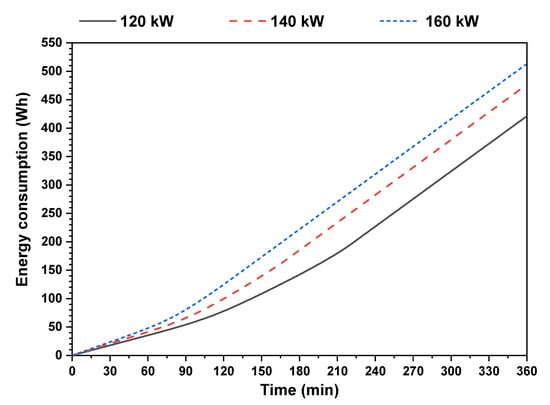
Figure 6.
Pump energy consumption during the functioning of the system: effect of thermal power loads.
All previously found results are summarized in Table 3.

Table 3.
TES thermal performances: the effect of generator thermal load.
4.2. Effect of PCM Tank Volume
In this section, the tank capacity is raised from 5 m3 to 7 m3 in order to explore the impact of changing the storage volume on system performances. The results are shown in Figure 7. It is noteworthy that PCM A118 is employed as the storage media, and the identical operational circumstances are maintained for all examined instances. Figure 7a depicts the change in the PCM tank’s output working-fluid temperature during the discharge procedure. It can be shown that increasing the PCM volume leads to an increase in both the production duration of hot working fluid from the tank and the duration of the discharging operation. The latter is increased by about 73% when the PCM tank volume is increased from 5 m3 to 10 m3. This behavior is due mainly to the increase in the storage capacity with the amount of used PCM in the tank. The change in the generated thermal power coming from the storage container is shown in Figure 7b. This result is given to highlight the impact of the PCM tank size on the system capacity to deliver the same thermal power for driving the cooling process. This graph indicates that increasing the quantity of utilized PCM in the tank benefits the chiller generator by extending the production period of unchanging heat rate of 120 kW. This duration of 120 kW constant power production from the tank is increased by about 62% when the PCM tank volume is increased from 5 m3 to 10 m3. This result confirms that the increase in the tank volume is suitable and will reduce the chiller generator energy consumption with a stable operation. As the proposed operation strategy of the coupled PCM tank-chiller generator is based on the regulation of mass flow rate, this variation is plotted in Figure 7c. It can be seen that for all studied cases, the mass flow rate variation follows the same behavior where it is low and stable at the start of the discharge procedure. When the discharge advances, the used mass flow rate in the system increases and it reaches a plateau due to the released latent heat at a nearly constant temperature from the storage unit. The output working temperature decreases at the end of the discharging operation, requiring the employment of a high mass-flow rate to provide the needed thermal power. By analyzing this figure, it can be observed that increasing the storage volume is beneficial as it leads to a reduction in the pump speed through using low values of the HTF flow rate. The maximal flow rate is reached rapidly when the use of minimal PCM volume is adopted and it is reached after 220 min and after 285 min from the beginning of the discharging operation for a tank volume of 5 m3 and 7 m3, respectively.
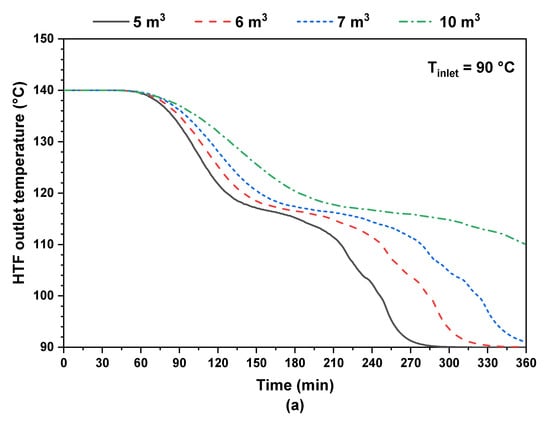

Figure 7.
(a) Outlet temperature variation from the tank, (b) generated thermal power coming from the storage unit, and (c) the flow rate variation of the working fluid.
The cumulative energy used by the circulation system for the three values of tank volume is shown in Figure 8. It can be seen that making the tank bigger has a small effect of the pump energy consumption. In fact, the increase in the PCM tank volume from 5 m3 to 10 m3 induces a reduction in the pump energy consumption by about 23%.
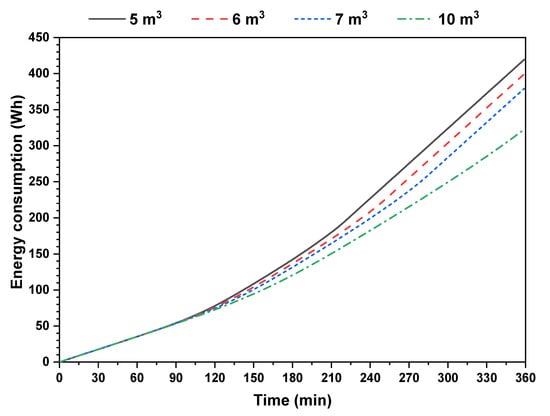
Figure 8.
Cumulated pump energy consumption during the discharge operation: effect of the tank volume.
All results found in this section are summarized in Table 4.

Table 4.
TES thermal performances: the effect of PCM tank volume.
4.3. Effect of PCM Type
The choice of the storage medium in the district cooling applications plays an important role as it directly affects the system performances and its reliability. To determine how the type of PCM storage media affects the system performance under study, three commercial PCMs were considered, i.e., A118 from PCM Products Ltd. (Yaxley, UK), Erythritol and MgCl2·6H2O [42], and the obtained results are given in Figure 9. The properties of these commercial PCMs are given in Table 1. By analyzing the produced working fluid temperature from the tank, it can be seen that the used PCM type in the DCS significantly affects the system performances. In fact, the use of Erythritol as PCM instead of A118 and MgCl2·6H2O is appropriate as it enables the output working temperature to be kept high and close to the PCM meeting point during the whole discharging duration (Figure 9a). This behavior is advantageous for the chiller generator as the latter performances increase with the used working fluid temperature [43]. The tank’s generated temperature remains between 140 °C and 115 °C when Erythritol is used as the storage system, between 140 °C and 100 °C for PCM MgCl2·6H2O and between 140 °C and 90 °C for PCM A118. Through analyzing Figure 9b, it is clear that using erythritol as a PCM results in the generation of steady thermal power of 120 kW during the whole discharging period of 6 h which will ensure a stable cooling power production. However, PCMs A118 and MgCl2·6H2O generate 120 kW of continuous thermal power production during only 3.6 h and 5.2 h, respectively. Thus, the period of continuous thermal power generation is increased by about 67% when Erythritol is used as PCM instead of PCM A118. Although these PCMs have the same phase-change melting interval, their performances are different. In fact, this behavior is due mainly to the difference in the storage density of each PCM and in particular the heat of fusion. The latter is equal to about 340 kJ/kg for Erythritol and only 195 kJ/kg for A118.
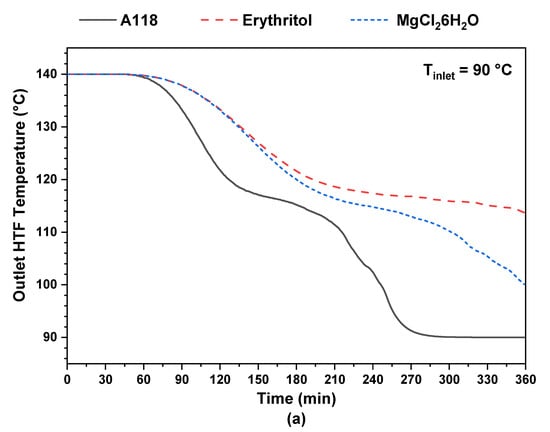
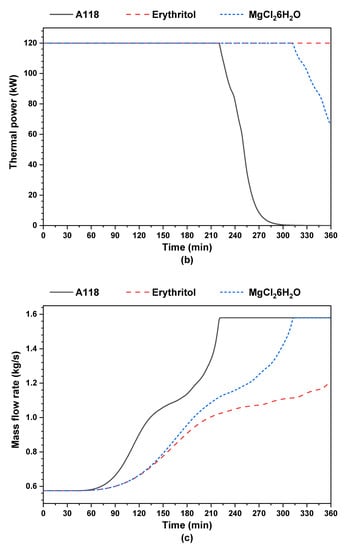
Figure 9.
(a) Outlet temperature variation from the tank, (b) generated thermal power coming from the storage unit, and (c) flow-rate variation of the working fluid.
Figure 9c represents the time-wise evolution of the used flow rate of fluid in the PCM tank during the discharge period for all studied cases. When A118 is used as the PCM instead of MgCl2·6H2O and Erythritol, the maximum flow rate is recorded. This behavior confirms that the PCM type also affects the hydraulic system performance and reduces its use when Erythritol is used as PCM instead of MgCl2·6H2O and A118.
To highlight the impact of the utilized PCM type on the hydraulic system energy consumption, the progression of the pump’s energy usage during the discharge cycle is depicted in Figure 10. This result clearly demonstrates that the storage media selection does not affect only the system thermal performances but also the pump energy consumption. The maximal value of pump energy consumption is reached when A118 is used as PCM and minimal pump energy consumption is obtained when Erythritol is employed as the tank’s storage medium. This pumping energy consumption is reduced by about 25% when Erythritol is used instead of PCM A118.

Figure 10.
Evolution of the pump energy consumption in the discharging operation: effect of the PCM type.
The previous obtained results can be summarized in Table 5.

Table 5.
TES thermal performances: The effect of PCM type.
5. Conclusions
A novel coupled PCM tank-120 kW chiller generator for cooling processes was suggested and examined numerically. The PCM tank was intended to provide consistent thermal power to the chiller generator with a suitable working fluid temperature during the peak cooling load period. The system was modeled using the lumped-capacitance approach, and the transition phase of the PCM physical state was simulated by adopting the method of effective thermal capacity. The system’s dynamic performance is assessed and the impacts of various factors on the PCM tank discharging process are given and examined. The numerical findings are firstly compared to experimental observations from an existing district network and the main findings can be summarized as the following:
- The suggested PCM storage tank can produce a continuous heat rate of 120 kW within 3.6 h, which is advantageous and reduces the chiller generator’s energy consumption during this period.
- Through increasing the thermal power needed by the generator cooling system from 120 kW to 160 kW, the duration of the PCM tank discharging process is decreased by about 20%, and the pump energy consumption is increased from 420 Wh to 512 Wh.
- The duration of 120 kW of constant power production from the tank is enhanced by about 62% when the PCM tank volume is increased from 5 m3 to 10 m3.
- The PCM tank volume variation has a small effect on the pump energy consumption. The latter is increased only by 23% when the tank volume is increased from 5 m3 to 10 m3.
- The utilization of erythritol as a medium for storage process is preferable to both PCMs A118 and MgCl2·6H2O.
- The period of continuous thermal power generation of 120 kW is increased by about 67% when erythritol is used as PCM instead of PCM A118.
In conclusion, it can be inferred that the utilization of the suggested PCM tank is suitable for improving the performances of the cooling systems and the proposed dynamic model is an appropriate tool for system design and simulation under multiple operation conditions. For perspectives the economic and the environmental impacts of the studied system will be presented and investigated in future works.
Author Contributions
Conceptualization, B.L. and E.A.; methodology, A.A.; software, B.L.; validation, A.A. and B.L.; formal analysis, A.A.; investigation, B.L.; resources, E.A.; writing—original draft preparation, B.L.; writing—review and editing, E.A.; visualization, A.A.; project administration, E.A.; funding acquisition, E.A. All authors have read and agreed to the published version of the manuscript.
Funding
This research was funded by the Agency for Research & Innovation in the Ministry of Education in Saudi Arabia grant number [IFKSUDR_E129] and the APC was funded by the same agency.
Institutional Review Board Statement
Not applicable.
Informed Consent Statement
Not applicable.
Data Availability Statement
Not applicable.
Acknowledgments
The authors extend their appreciation to the Agency for Research & Innovation in the Ministry of Education in Saudi Arabia for funding this research work through the project number (IFKSUDR_E129).
Conflicts of Interest
The authors declare no conflict of interest. The funders had no role in the design of the study; in the collection, analyses, or interpretation of data; in the writing of the manuscript; or in the decision to publish the results.
References
- Santos, F.D.; Ferreira, P.L.; Pedersen, J.S.T. The Climate Change Challenge: A Review of the Barriers and Solutions to Deliver a Paris Solution. Climate 2022, 10, 75. [Google Scholar] [CrossRef]
- Gjoka, K.; Rismanchi, B.; Crawford, R.H. Fifth-Generation District Heating and Cooling Systems: A Review of Recent Advancements and Implementation Barriers. Renew. Sustain. Energy Rev. 2023, 171, 112997. [Google Scholar] [CrossRef]
- Mortadi, M.; El Fadar, A. Performance, Economic and Environmental Assessment of Solar Cooling Systems under Various Climates. Energy Convers. Manag. 2022, 252, 114993. [Google Scholar] [CrossRef]
- Jahanger, A.; Ozturk, I.; Chukwuma Onwe, J.; Joseph, T.E.; Razib Hossain, M. Do Technology and Renewable Energy Contribute to Energy Efficiency and Carbon Neutrality? Evidence from Top Ten Manufacturing Countries. Sustain. Energy Technol. Assess. 2023, 56, 103084. [Google Scholar] [CrossRef]
- Zafar, M.W.; Saeed, A.; Zaidi, S.A.H.; Waheed, A. The Linkages among Natural Resources, Renewable Energy Consumption, and Environmental Quality: A Path toward Sustainable Development. Sustain. Dev. 2021, 29, 353–362. [Google Scholar] [CrossRef]
- Eveloy, V.; Ayou, D.S. Sustainable District Cooling Systems: Status, Challenges, and Future Opportunities, with Emphasis on Cooling-Dominated Regions. Energies 2019, 12, 235. [Google Scholar] [CrossRef]
- Alajmi, A.; Zedan, M. Energy, Cost, and Environmental Analysis of Individuals and District Cooling Systems for a New Residential City. Sustain. Cities Soc. 2020, 54, 101976. [Google Scholar] [CrossRef]
- Østergaard, P.A.; Werner, S.; Dyrelund, A.; Lund, H.; Arabkoohsar, A.; Sorknæs, P.; Gudmundsson, O.; Thorsen, J.E.; Mathiesen, B.V. The Four Generations of District Cooling—A Categorization of the Development in District Cooling from Origin to Future Prospect. Energy 2022, 253, 124098. [Google Scholar] [CrossRef]
- Gong, Y.; Ma, G.; Jiang, Y.; Wang, L. Research Progress on the Fifth-Generation District Heating System Based on Heat Pump Technology. J. Build. Eng. 2023, 71, 106533. [Google Scholar] [CrossRef]
- Sulzer, M.; Werner, S.; Mennel, S.; Wetter, M. Vocabulary for the Fourth Generation of District Heating and Cooling. Smart Energy 2021, 1, 100003. [Google Scholar] [CrossRef]
- García-Céspedes, J.; Herms, I.; Arnó, G.; de Felipe, J.J. Fifth-Generation District Heating and Cooling Networks Based on Shallow Geothermal Energy: A Review and Possible Solutions for Mediterranean Europe. Energies 2023, 16, 147. [Google Scholar] [CrossRef]
- Li, G.; Zheng, X. Thermal Energy Storage System Integration Forms for a Sustainable Future. Renew. Sustain. Energy Rev. 2016, 62, 736–757. [Google Scholar] [CrossRef]
- Nie, B.; Palacios, A.; Zou, B.; Liu, J.; Zhang, T.; Li, Y. Review on Phase Change Materials for Cold Thermal Energy Storage Applications. Renew. Sustain. Energy Rev. 2020, 134, 110340. [Google Scholar] [CrossRef]
- Abd Majid, M.A.; Muhammad, M.; Hampo, C.C.; Akmar, A.B. Analysis of a Thermal Energy Storage Tank in a Large District Cooling System: A Case Study. Processes 2020, 8, 1158. [Google Scholar] [CrossRef]
- Dincer, I.; Rosen, M.A. Energetic, Environmental and Economic Aspects of Thermal Energy Storage Systems for Cooling Capacity. Appl. Therm. Eng. 2001, 21, 1105–1117. [Google Scholar] [CrossRef]
- Fiorentini, M.; Heer, P.; Baldini, L. Design Optimization of a District Heating and Cooling System with a Borehole Seasonal Thermal Energy Storage. Energy 2023, 262, 125464. [Google Scholar] [CrossRef]
- Tang, H.; Yu, J.; Geng, Y.; Liu, X.; Lin, B. Optimization of Operational Strategy for Ice Thermal Energy Storage in a District Cooling System Based on Model Predictive Control. J. Energy Storage 2023, 62, 106872. [Google Scholar] [CrossRef]
- Todorov, O.; Alanne, K.; Virtanen, M.; Kosonen, R. A Method and Analysis of Aquifer Thermal Energy Storage (ATES) System for District Heating and Cooling: A Case Study in Finland. Sustain. Cities Soc. 2020, 53, 101977. [Google Scholar] [CrossRef]
- Guelpa, E.; Verda, V. Thermal Energy Storage in District Heating and Cooling Systems: A Review. Appl. Energy 2019, 252, 113474. [Google Scholar] [CrossRef]
- Lamrani, B.; Belcaid, A.; Lebrouhi, B.E.; Khodadadi, J.M.; El Rhafiki, T. Dynamic Thermal Analysis of a Coupled Solar Water Heaters-Thermal Storage Tank for Solar Powered District Heating Networks. J. Energy Storage 2023, 61, 106793. [Google Scholar] [CrossRef]
- Abánades, A.; Rodríguez-Martín, J.; Roncal, J.J.; Caraballo, A.; Galindo, F. Proposal of a Thermocline Molten Salt Storage Tank for District Heating and Cooling. Appl. Therm. Eng. 2023, 218, 119309. [Google Scholar] [CrossRef]
- Hlimi, M.; Lebrouhi, B.E.; Belcaid, A.; Lamrani, B.; Balli, L.; Ndukwu, M.C.; El Rhafiki, T.; Kousksou, T. A Numerical Assessment of a Latent Heat Storage System for District Heating Substations. J. Energy Storage 2023, 57, 106210. [Google Scholar] [CrossRef]
- Soh, A.; Huang, Z.; Chen, W.; Islam, M.R.; Chua, K.J. Design Optimization of Low-Temperature Latent Thermal Energy Storage for Urban Cooling Applications. Appl. Therm. Eng. 2023, 230, 120711. [Google Scholar] [CrossRef]
- Bastida, H.; De la Cruz-Loredo, I.; Ugalde-Loo, C.E. Effective Estimation of the State-of-Charge of Latent Heat Thermal Energy Storage for Heating and Cooling Systems Using Non-Linear State Observers. Appl. Energy 2023, 331, 120448. [Google Scholar] [CrossRef]
- Shirazi, A.; Taylor, R.A.; Morrison, G.L.; White, S.D. Solar-Powered Absorption Chillers: A Comprehensive and Critical Review. Energy Convers. Manag. 2018, 171, 59–81. [Google Scholar] [CrossRef]
- Lamrani, B.; Kousksou, T. Numerical Investigation of a Shell-and-Tube Latent Heat Thermal Energy Storage System for Urban Heating Network. J. Energy Storage 2021, 43, 103216. [Google Scholar] [CrossRef]
- Lamrani, B.; Kuznik, F.; Draoui, A. Thermal Performance of a Coupled Solar Parabolic Trough Collector Latent Heat Storage Unit for Solar Water Heating in Large Buildings. Renew. Energy 2020, 162, 411–426. [Google Scholar] [CrossRef]
- Lamrani, B.; Draoui, A. Modelling and Simulation of a Hybrid Solar-Electrical Dryer of Wood Integrated with Latent Heat Thermal Energy Storage System. Therm. Sci. Eng. Prog. 2020, 18, 100545. [Google Scholar] [CrossRef]
- Wang, J.; Yan, R.; Wang, Z.; Zhang, X.; Shi, G. Thermal Performance Analysis of an Absorption Cooling System Based on Parabolic Trough Solar Collectors. Energies 2018, 11, 2679. [Google Scholar] [CrossRef]
- PlusICE®. Available online: www.pcmproducts.net (accessed on 3 March 2023).
- Agyenim, F. The Use of Enhanced Heat Transfer Phase Change Materials (PCM) to Improve the Coefficient of Performance (COP) of Solar Powered LiBr/H2O Absorption Cooling Systems. Renew. Energy 2016, 87, 229–239. [Google Scholar] [CrossRef]
- Mostafavi, S.S.; Taylor, R.A.; Saberi, P.; Diarce, G. Design and Feasibility of High Temperature Shell and Tube Latent Heat Thermal Energy Storage System for Solar Thermal Power Plants. Renew. Energy 2016, 96, 120–136. [Google Scholar] [CrossRef]
- Elbahjaoui, R.; El Qarnia, H. Thermal Performance of a Solar Latent Heat Storage Unit Using Rectangular Slabs of Phase Change Material for Domestic Water Heating Purposes. Energy Build. 2019, 182, 111–130. [Google Scholar] [CrossRef]
- Lamrani, B.; Khouya, A.; Zeghmati, B.; Draoui, A. Mathematical Modeling and Numerical Simulation of a Parabolic Trough Collector: A Case Study in Thermal Engineering. Therm. Sci. Eng. Prog. 2018, 8, 47–54. [Google Scholar] [CrossRef]
- Gnielinski, V. On Heat Transfer in Tubes. Int. J. Heat Mass Transf. 2013, 63, 134–140. [Google Scholar] [CrossRef]
- Bentivoglio, F.; Rouge, S.; Soriano, O.; Tempass de Sousa, A. Design and Operation of a 180 kWh PCM Heat Storage at the Flaubert Substation of the Grenoble Urban Heating Network. Appl. Therm. Eng. 2021, 185, 116402. [Google Scholar] [CrossRef]
- Medved, I.; Trník, A.; Vozár, L. Modeling of Heat Capacity Peaks and Enthalpy Jumps of Phase-Change Materials Used for Thermal Energy Storage. Int. J. Heat Mass Transf. 2017, 107, 123–132. [Google Scholar] [CrossRef]
- Halimov, A.; Lauster, M.; Müller, D. Validation and Integration of a Latent Heat Storage Model into Building Envelopes of a High-Order Building Model for Modelica Library AixLib. Energy Build. 2019, 202, 109336. [Google Scholar] [CrossRef]
- El Ouali, A.; Khattari, Y.; Lamrani, B.; El Rhafiki, T.; Zeraouli, Y.; Kousksou, T. Apparent Heat Capacity Method to Describe the Thermal Performances of a Latent Thermal Storage System during Discharge Period. J. Energy Storage 2022, 52, 104960. [Google Scholar] [CrossRef]
- Feustel, H. Simplified Numerical Description of Latent Storage Characteristics for Phase Change Wallboard; Lawrence Berkeley National Laboratory: Berkeley, CA, USA, 1995.
- Lamrani, B.; Lebrouhi, B.E.; Khattari, Y.; Kousksou, T. A Simplified Thermal Model for a Lithium-Ion Battery Pack with Phase Change Material Thermal Management System. J. Energy Storage 2021, 44, 103377. [Google Scholar] [CrossRef]
- Höhlein, S.; König-Haagen, A.; Brüggemann, D. Thermophysical Characterization of MgCl2·6H2O, Xylitol and Erythritol as Phase Change Materials (PCM) for Latent Heat Thermal Energy Storage (LHTES). Materials 2017, 10, 444. [Google Scholar] [CrossRef]
- Al-Yasiri, Q.; Szabó, M.; Arıcı, M. A Review on Solar-Powered Cooling and Air-Conditioning Systems for Building Applications. Energy Rep. 2022, 8, 2888–2907. [Google Scholar] [CrossRef]
Disclaimer/Publisher’s Note: The statements, opinions and data contained in all publications are solely those of the individual author(s) and contributor(s) and not of MDPI and/or the editor(s). MDPI and/or the editor(s) disclaim responsibility for any injury to people or property resulting from any ideas, methods, instructions or products referred to in the content. |
© 2023 by the authors. Licensee MDPI, Basel, Switzerland. This article is an open access article distributed under the terms and conditions of the Creative Commons Attribution (CC BY) license (https://creativecommons.org/licenses/by/4.0/).